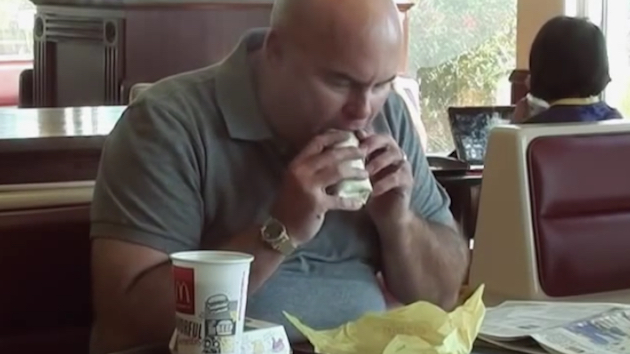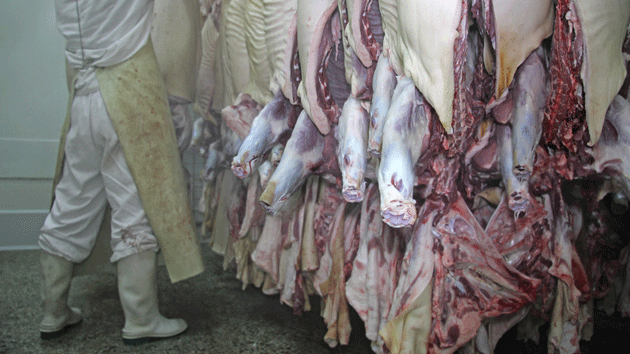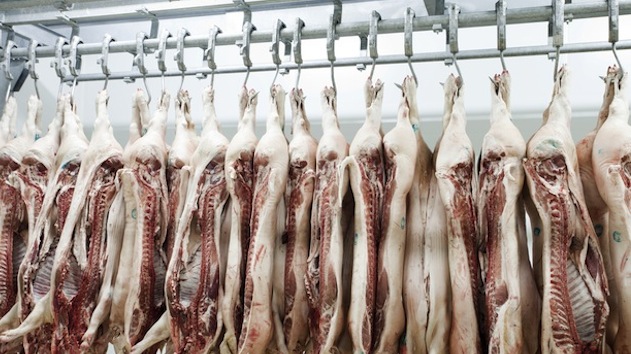Earlier today, animal rights organization Compassion Over Killing released a new undercover video shot at the Quality Pork Processors (QPP) plant in Austin, Minnesota. That cut-and-kill operation is part of the Hormel Foods Corporation’s flagship complex that I first wrote about for Mother Jones in 2011.
QPP processes between 19,000 and 22,000 hogs per day depending on demand, making it one of the most productive facilities in the country. But the video also suggests that the volume and speed of processing results in shocking mistreatment of animals. Downed hogs are shown being kicked and dragged toward the slaughter area. Some conscious hogs are shown shackled to the conveyor chain, while others, still alive, have their throats slit and are sent to the scalding tank. The video also documents hogs with pus-filled abscesses and what appears to be fecal contamination being processed for food—as well as an employee who seems to be nodding off at his workstation.
US Department of Agriculture (USDA) spokesperson Adam Tarr told the Washington Post, “The actions depicted in the video under review are appalling and completely unacceptable, and if we can verify the video’s authenticity, we will aggressively investigate the case and take appropriate action,” but Tarr did not note that this plant has been held up by the USDA as the model for a pork inspection nationwide.
In response to an email query from Mother Jones about the video, a Hormel spokesperson wrote:
QPP as [sic] a third-party supplier to our company.
Hormel Foods is committed to animal care and has high standards and policies with our suppliers. We have a zero tolerance policy for the inhumane treatment of animals, and we remain dedicated to the highest standards for animal care and handling.
Routine audits are conducted at all facilities, and we hire third-party auditors to ensure the highest animal care procedures are followed.
Our suppliers operate under very visible conditions, including third-party video monitoring and the USDA is present during all operations. We will review the video and will take action if warranted.
Meanwhile, the Associated Press reported that QPP disciplined two of the employees associated with the video; Minnesota’s ABC 6 News reported that one of those two was the filmer.
The QPP/Hormel Foods plant in Austin is one of just five pork processing plants in the country where the USDA was running a pilot program to test the effects of reducing the number of government meat inspectors. The idea sounds crazy on its face: Why would the USDA, the agency created to ensure food safety, propose cutting inspectors? As I reported earlier this year, the pilot program, known as the Hazard Analysis and Critical Control Points-based based Inspection Models Project (HIMP), was presented as a faster, more modern “risk-based, prevention-oriented” approach which could replace slower, manual inspection of all carcasses.
A strong supporter of the plan, back when it was implemented in the early 2000s, was Hormel’s then-CEO Joel W. Johnson. Advocates argued that if plants hired their own quality-assurance auditors to sort out diseased animals before they reached USDA inspection stations, that would reduce the chance of cross-contamination, and inspectors could focus on spots along the line where contamination was most likely to occur and perform random microbiological tests in those places. Five pork-processing facilities nationwide were selected for the program—and Johnson managed to get the head of the USDA’s Food Safety Inspection Service (FSIS), to include both of the slaughter operations that Hormel operated into that select handful. (And Hormel bought a third plant in the program soon after.)
As I reported in Bloomberg Businessweek, Pablo Ruiz, a former process-control auditor at QPP, told me that the production line in Austin was running so fast that the lone government inspector just sat in a chair watching carcasses rush by, because he only had time to do visual inspections. I wrote in Bloomberg Businessweek:
USDA inspectors are typically required to check the tail, head and tongue, thymus, and all viscera of each hog. They palpate the lymph nodes of the large intestines and lower abdomen to feel for tuberculosis nodules, feel the intestines themselves for parasites, and turn over every set of kidneys to check for hardness resulting from inflammation or hidden masses.
At QPP, Ruiz said, the inspectors just visually double-checked the work of process-control auditors. And even QPP’s auditors didn’t have time to inspect viscera.
“We just check at the head,” Ruiz says, adding that he doesn’t think there is enough government oversight and that the USDA should double-check the work of process-control auditors. But the lack of oversight, he says, is “why the line goes so fast. When I was there, it was 1,305 per hour. This means 10,000 hogs achieved every eight hours. That’s money in the bank—easy, quick.” (QPP did not respond to telephone requests for comment, as well as a more detailed e-mail. Two messages left on Quality Pork CEO Kelly Wadding’s voicemail also went unreturned.)
About that same time, Elsa Murano, who had left her post at the USDA as Undersecretary for Food Safety soon after HIMP was approved, was hired by Hormel Foods to serve on the board of directors. (Nearly ten years later, she still holds that position—at an annual salary of more than $200,000 with total stock holding valued at over $2 million.)
In January of this year, as Mother Jones‘ Tom Philpott reported, four inspectors from Hormel-controlled facilities filed affidavits attesting to violations of food safety standards with the whistleblower protection organization Government Accountability Project (GAP). Joe Ferguson, who retired last September as an on-line USDA inspector inside QPP, was the most pointed. In discussing HIMP, Ferguson said, “It is my personal opinion that there is no inspection of carcasses under this program.”
Like Ruiz, Ferguson attributed the decreased attention to food safety to the desire to increase line speeds. And, he said, at the same time, USDA was reclassifying food safety violations so that they no longer required work stoppages for cleaning. “We used to stop the line for bile contamination, chronic pleuritis, hair/toenails/scurf . . . [U]nder HIMP,” he said, “we are no longer allowed to stop the line so they may be removed. Put ’em in the cooler and ultimately out to the consumer.” As for the reason that such changes were occurring, Ferguson didn’t mince words. “FSIS hierarchy is in bed with the regulated industry,” he said. He pointed to Murano’s move to Hormel as an example of the kind of sway that industry now held over the USDA. “The companies are now calling the shots,” Ferguson said. “Pretty soon the agency will have no authority.”
In a report issued in May 2013, the USDA’s Office of the Inspector General said that the kinds of problems allegedly occurring in those facilities should have resulted in a written warning or even a plant suspension, but few actions were taken. The report concluded that the Inspector General’s investigation “revealed a systemic failure and not a sporadic problem” and warned: “It is critical that plants work towards preventing violations from occurring in the first place because recurring, severe violations may jeopardize public health.” Stricter enforcement, the report concluded, is necessary to ensure that “the nation’s commercial supply of pork is safe and wholesome.” Instead one year ago, FSIS not only approved the continuation of the HIMP pilot project but called for the start of a review period to determine if the program “could be applied to additional establishments.” And in today’s Washington Post article, Phil Derfler, the deputy administrator at FSIS, is quoted defending HIMP. “It’s an improvement on the traditional system,” he is quoted as saying, even though the USDA is still supposed to be reviewing data to make that determination.
If, indeed, the USDA still intends to proceed with HIMP, the release of Compassion Over Killing’s video should dramatically complicate those plans. When the public sees that the project has resulted in the kinds of animal cruelty and food safety risks recorded there, they may think twice about consuming Hormel products. Joe Ferguson, the USDA inspector who certified meat from that plant for more than ten years, said, “Personally, I will not eat any products that bear the name of the company for which this meat is produced.”
But the conditions portrayed in this horrifying video cannot be brushed aside as an isolated series of events in a single pork plant or even a single company. The bigger issue is that the USDA’s Food Safety and Inspection Service is saying QPP is a model plant. After seeing this video, it’s hard to imagine that consumers will agree.












